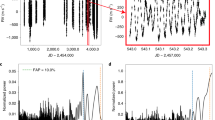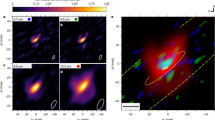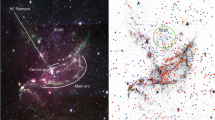Abstract
IT is not yet possible to see planets orbiting other stars, although this may soon change as observing methods improve1. Indirect evidence for the presence of circumstellar dust disks out of which planets could form has been obtained for several stars, in the form of excess infrared emission, presumed to be from the hot dust2, 3. Planets orbiting in such dust disks would be expected to sweep out dust-free tracks4. Indirect evidence for dust-free regions has been reported5–9, based on an analysis of the spectral energy distribution, but the interpretation of the observation is not unique7, 9. Here we present an infrared image of the inner dust disk of the star β Pictoris with a linear resolution of 5 astronomical units (AU), equivalent to the distance from the Sun to Jupiter. We find that the dust is asymmetrically distributed and is clearly depleted within 40 AU of the star, which we interpret as indicating the possible presence of at least one planetary body orbiting β Pictoris.
This is a preview of subscription content, access via your institution
Access options
Subscribe to this journal
Receive 51 print issues and online access
$199.00 per year
only $3.90 per issue
Buy this article
- Purchase on Springer Link
- Instant access to full article PDF
Prices may be subject to local taxes which are calculated during checkout
Similar content being viewed by others
References
Angel, J. R. P. Nature 368, 203–207 (1994).
Aumann, H. H. Publs astr. Soc. Pacif. 97, 885–891 (1985).
Backman, D. E. & Paresce, F. in Protostars and Planets III (eds Levy, E. H., Lumine, J. I. & Matthews, M. S.) 208–253 (Univ. Arizona Press, Tucson, 1993).
Paresce, F. Adv. Space Res. 12, 157–167 (1992).
Gillett, F. C. in Light on Dark Matter (ed. Israel, F. P.) 61–69 (Reidel, Dordrecht, 1986).
Diner, D. J. & Appleby, J. F. Nature 322, 436–438 (1986).
Artymowicz, P., Burrows, C. & Paresce, F. Astrophys. J. 337, 494–513 (1989).
Telesco, C. M., Becklin, E. E., Wolstencroft, R. D. & Decher, R. Nature 335, 51–53 (1986).
Backman, D. E., Gillett, F. C. & Witteborn, F. C. Astrophys. J. 385, 670–679 (1992).
Smith, B. A. & Terrile, R. J. Science 226, 1421–1424 (1984).
Lecavelier des Etangs, A. et al. Astr. Astrophys. 274, 877–882 (1993).
Golimowski, D. A., Durrance, S. T. & Clampin, M. Astrophys. J. 411, L41–L44 (1993).
Lagage, P. O. et al. in Infrared Detectors and Instrumentation Vol. 1946 (ed. Fowler, A. W.) 655–666 (SPIE, Orlando, Florida, 1993).
Telesco, C. M. & Knacke, R. F. Astrophys. J. 372, L29–L31 (1991).
Aitken, D. K., Moore, T. J. T., Roche, P. F., Smith, C. H. & Wright, C. M. Mon. Not. R. astr. Soc. 265, L41–L43 (1993).
Richardson, B. H. J. opt. Soc. Am. 62, 55–59 (1972).
Lucy, L. B. Astrophys. J. 79, 745–754 (1974).
Starck, J. L. & Murtagh, F. Astr. Astrophys. (in the press).
Knacke, R. F. et al. Astrophys. J. 418, 440–450 (1993).
Isobe, S. Publs astr. Soc. Japan 22, 429–445 (1970).
Roque, F., Scholl, H., Sicardy, B. & Smith, B. Icarus (in the press).
Nakano, T. Mon. Not. H. astr. Soc. 224, 107–130 (1987).
Lagrange-Henri, A. M., Vidal-Madjar, A. & Ferlet, R. Astr. Astrophys. 190, 275–282 (1988).
Ferlet, R. et al. Astr. Astrophys. 267, 137–144 (1993).
Césarsky, C. in Infrared Astronomy with Arrays: the Next Generation (ed. McLean, I.) 261–268 (Astrophysics and Space Science Library Vol. 190, Kluwer Academic, Dordrecht, 1994).
Draine, B. T. Astrophys. J. Suppl. Ser 57, 587–594 (1985).
Skinner, C. J., Barlow, M. J. & Justtanont, K. Mon. Not. R. astr. Soc. 255, 31P–36P (1992).
Author information
Authors and Affiliations
Rights and permissions
About this article
Cite this article
Lagage, P., Pantin, E. Dust depletion in the inner disk of β Pictoris as a possible indicator of planets. Nature 369, 628–630 (1994). https://doi.org/10.1038/369628a0
Received:
Accepted:
Issue Date:
DOI: https://doi.org/10.1038/369628a0
This article is cited by
-
Evidence for an additional planet in the β Pictoris system
Nature Astronomy (2019)
-
Optical properties of dust aggregates in the disk of Beta Pictoris
Earth, Planets and Space (2014)
-
Comet-like mineralogy of olivine crystals in an extrasolar proto-Kuiper belt
Nature (2012)
-
Dust in the solar system and in extra-solar planetary systems
The Astronomy and Astrophysics Review (2006)
Comments
By submitting a comment you agree to abide by our Terms and Community Guidelines. If you find something abusive or that does not comply with our terms or guidelines please flag it as inappropriate.



